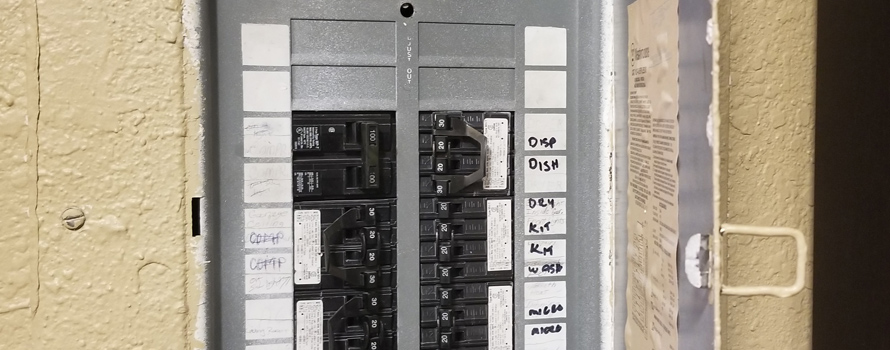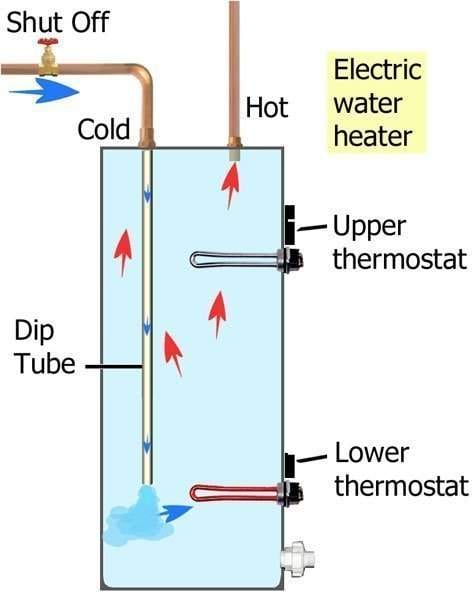If your water heater trips the breaker after a few minutes, it could be due to an electrical overload or a faulty heating element. To troubleshoot this issue, check for loose wiring, a high thermostat setting, or a malfunctioning heating element.
Additionally, ensure that the circuit breaker is the correct size for the water heater and that there are no other appliances drawing power from the same circuit. It’s also important to consider the age and condition of the water heater, as older units may experience more frequent issues.
By addressing these potential causes, you can identify and resolve the problem to enjoy consistent hot water supply.

Credit: www.reddit.com
Page Contents
- 1 Introduction To Water Heater Electrical Issues
- 2 Identifying The Problem
- 3 Common Causes For Tripping Breakers
- 4 Resetting The Breaker: Step-by-step
- 5 Inspecting The Heating Elements
- 6 Water Heater Thermostat Issues
- 7 Preventive Maintenance Tips
- 8 When To Upgrade Your Water Heater
- 9 Frequently Asked Questions
- 10 Conclusion
Introduction To Water Heater Electrical Issues
If your water heater trips the breaker after running for a few minutes, it could be a sign of electrical problems. Common signs include flickering lights, burning smell, or sparks from the water heater. When dealing with these issues, always prioritize safety. Ensure the power is turned off before inspecting any electrical components. It’s crucial to call a professional if you’re unsure about handling electrical work. Remember, electrical problems with water heaters can pose serious risks, so it’s essential to address them promptly and with caution.

Credit: simpsonplumbingservices.com
Identifying The Problem
When a water heater trips the breaker after a few minutes, it can be frustrating. Identifying the problem requires some initial checks. First, ensure that the water heater is the only appliance on the circuit. Then, check for loose wiring connections and corrosion. Using a multimeter, test the heating elements and thermostats for continuity. Additionally, make sure the breaker size matches the unit’s specifications. Tools needed for troubleshooting include a multimeter, screwdriver, and safety gloves. By following these steps, you can effectively identify and address the issue causing the water heater to trip the breaker.
Common Causes For Tripping Breakers
Tripping breakers in a water heater can be caused by a few common factors. One possible cause is faulty heating elements, which can lead to an overload of electricity and cause the breaker to trip. Another potential cause is a short circuit in the internal wiring of the water heater. This can occur due to damaged or frayed wires, which can create a surge of electricity and trip the breaker. It is important to address these issues promptly to prevent further damage to the water heater and ensure its safe operation.
Resetting The Breaker: Step-by-step
Resetting the breaker is a step-by-step process that can help resolve the issue of your water heater tripping the breaker after a few minutes. To safely reset your breaker, follow these steps:
- Locate the breaker panel in your home.
- Identify the breaker that has tripped; it should be in the “off” position.
- Switch the breaker to the “on” position.
- If the breaker immediately trips again, there may be a more serious issue.
- In such cases, it is advisable to call a professional for assistance.
Calling a professional is recommended when the breaker continues to trip after resetting it. A licensed electrician will have the expertise to diagnose the problem and provide a safe solution. Attempting to fix electrical issues without proper knowledge can be dangerous and lead to further damage. Prioritizing your safety and the integrity of your home’s electrical system is essential when dealing with breaker tripping problems.
Inspecting The Heating Elements
When a water heater trips the breaker after a few minutes, the heating elements are often the culprit. To inspect them, turn off the power supply and remove the access panels. Check for any visible damage such as corrosion or burn marks.
| Testing the elements for functionality: | Replacing a damaged heating element: |
|---|---|
| Using a multimeter, test the resistance of each element. If the resistance is too high or too low, the element is faulty and needs to be replaced. | After purchasing a new heating element, turn off the power and drain the tank. Remove the old element and install the new one, making sure to properly tighten all connections. |
Regular maintenance of your water heater can prevent heating element issues and ensure efficient operation. This includes flushing the tank annually and checking the temperature and pressure relief valve regularly. By taking these steps, you can avoid tripping the breaker and keep your water heater running smoothly.

Credit: georgebrazilplumbingelectrical.com
Water Heater Thermostat Issues
One of the most common issues with a water heater is a malfunctioning thermostat. If your water heater trips the breaker after a few minutes, it may be due to thermostat issues. The first step in diagnosing a thermostat malfunction is to check the temperature setting. If the setting is too high, it can cause the breaker to trip. Adjust the temperature to a lower setting and see if that resolves the issue.
If adjusting the temperature doesn’t work, you may need to replace the thermostat. Before replacing the thermostat, turn off the power to the water heater and drain the tank. Remove the access panel and disconnect the wires from the thermostat. Install the new thermostat, reconnect the wires, and replace the access panel. Turn the power back on and test the water heater to see if the issue has been resolved.
| Steps to Diagnose Thermostat Malfunctions: |
|---|
| 1. Check the temperature setting. |
| 2. Adjust the temperature to a lower setting. |
| 3. If the issue persists, turn off the power to the water heater and drain the tank. |
| 4. Remove the access panel and disconnect the wires from the thermostat. |
| 5. Install the new thermostat, reconnect the wires, and replace the access panel. |
| 6. Turn the power back on and test the water heater. |
Preventive Maintenance Tips
Regular inspection schedules and cleaning are essential for ensuring the longevity of your water heater and preventing it from tripping the breaker after just a few minutes of use.
Inspect your water heater regularly to check for any signs of wear and tear, such as leaks, rust, or loose connections. It’s also important to clean the tank and remove any sediment buildup that can affect its efficiency.
To clean the tank, turn off the power supply and drain the water heater. Use a hose to flush out any sediment or debris that may have accumulated at the bottom. You can also consider installing a sediment filter to prevent further buildup.
Additionally, check the pressure relief valve to ensure it is functioning properly. This valve helps prevent excessive pressure from building up inside the tank, which can lead to a tripped breaker.
By following these preventive maintenance tips and performing regular inspections and cleanings, you can extend the lifespan of your water heater and avoid the inconvenience of a tripped breaker.
When To Upgrade Your Water Heater
If your water heater trips the breaker after just a few minutes of use, it may be time to consider upgrading to a more energy-efficient model. Upgrading your water heater not only ensures a reliable supply of hot water but can also save you money on your energy bills. Modern water heaters come with advanced features and benefits that can improve the overall efficiency of your home.
By upgrading to an energy-efficient water heater, you can reduce your carbon footprint and contribute to a more sustainable environment. These new models often have better insulation, more precise temperature control, and quicker heating capabilities. Additionally, they may incorporate smart technology that allows you to monitor and control your water heater remotely, optimizing energy usage.
Consider consulting with a professional plumber or HVAC technician to assess your current water heater and determine the best upgrade option for your specific needs. Investing in a new water heater can provide long-term benefits in terms of energy savings and improved performance.
Frequently Asked Questions
Why Does My Heater Trip The Breaker After A Few Minutes?
Your heater may trip the breaker due to overloading, a faulty thermostat, or a short circuit. It’s best to have a professional inspect and repair the issue to ensure safe and efficient operation.
What Do You Do When Your Hot Water Heater Breaker Keeps Tripping?
If your hot water heater breaker keeps tripping, check for a short circuit or overload. Reset the breaker and observe for any unusual activity in the heater. If the problem persists, seek professional help to diagnose and fix the issue.
Why Does My Water Heater Run For A Few Minutes Then Shut Off?
A water heater may run for a few minutes and then shut off due to various reasons. It could be a faulty thermostat, a buildup of sediment in the tank, a malfunctioning heating element, or an issue with the gas supply (if it’s a gas water heater).
It’s best to consult a professional plumber to diagnose and fix the problem.
Why Does My Heat Pump Trip The Breaker After A Few Minutes?
A heat pump that trips the breaker after a few minutes could be due to several reasons. It may be caused by a dirty air filter, faulty wiring, or a malfunctioning compressor. It’s best to call a professional HVAC technician to diagnose and fix the issue.
Conclusion
To wrap up, a water heater that trips the breaker after a few minutes can be a frustrating problem for homeowners. However, with proper troubleshooting and maintenance, this issue can be resolved. From checking the thermostat to inspecting the heating elements, following the steps outlined can help identify and fix the root cause of the issue.
By taking the necessary steps to maintain your water heater, you can ensure that it runs efficiently and reliably for years to come.
